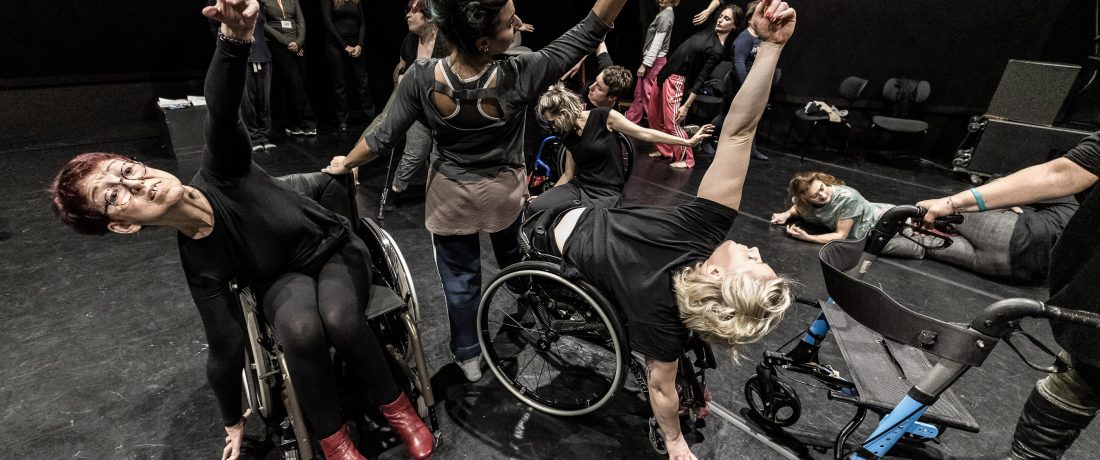
Floor Work and Partnering
TARGET GROUP
adults with and without disabilitiesPARTICIPANTS
18-22DURATION
1.5 hoursORGANIZATION
Stopgap Dance CompanyGoal - Essential question
Exploration on use of floor work building up to partnering, using thoughtful transference of weight.
Improvisation (10 minutes)
Start by lying down on the floor with your eyes closed, image a small circle that starts moving from your belly button. Gradually the circle starts to travel through your whole body. Send the circles away from the floor and back down. Find a flow like the seaweed under the water
Mobilization and Weight (15 minutes)
Come up to a sitting position, start circling with your wrist and ankle and reverse, then swap sides. Transfer some weight on the floor through your hands and feet building up with different surfaces. Keep transferring weight through different body parts to find different levels. Focus on a smooth pouring of the weight, softening into the floor. You do not have to move constantly, find moments to pause and be aware of the position you are in. Start using these moves to travel around the space.
Progression: Try to be aware of and find specific movements that you find interesting, repeat, remember and refine them.
Outcome: Poring weight through different body parts.
Back on the floor (15 minutes)
Using a steady pace, lead a sequence of simple moves on the floor and repeat it. Then, add on to the sequence with moves from the participants. (Ask them to think about the move that are most useful to them, it might be moves that they did in the previous improvisations.)*
Progression: Repeat the same moves with a different speed and texture.
Outcome: Building up a movement sequence and finding a flow.
There is an example of this exercise in the iDance Learning Corner, Digital Material – Floor work with Nadenh by Stopgap Dance Company.
Partner introduction (15 minutes)
Using the movement ideas explored so far in the session, start a movement conversation with a partner, where you move and respond to each other. Make sure you have time when you are watching your partner as well as moving. Try including the way your partner moves in some of your own movement. Gradually getting closer to your partner, start feeding in and out of their shapes. Find moments to connect with your partner, pause and breathe into these connections.
Outcome: Getting to know your partner.
Floor partner work (30 minutes)
Keeping the same partner, name yourselves person A or B. Person A makes a low strong base, any position that they feel comfortable, stable and able to hold. Person B looks around the shape, and finds a good place to transfer and pour their weight onto person A. Once there, take a moment to check that you are really released into the other person. Breath together, then person B pours their weight back of person A. Then person A makes a new strong base and person B finds a way to pour weight onto them. Repeat a number of times, then swap roles. You can start with resting extremities on your partner, and gradually build up to working center to center. Try to find a different journey out of the shape, rather than just reversing it. Keep checking with your partner when you transfer your weight on them, that they are ok with the weight you are giving them. Once you have both had a go at being the base, try alternating between the two roles, swapping each time who is the base and who is pouring their weight. Think about how you move into and out of the shapes. For the transitions, try both staying in contact with each other and finding space between each other. Start finding fluidity between the changing shapes, so your movements start overlap rather than pausing in between them. Can you give your full weight to your partner so you do not have anything touching the ground? Can the person being the base gently shift to aid the other person’s journey out of their weight giving? When both of you feel confident, you can add on different levels, maybe getting a little bit higher.
Progression: Find shapes and weight sharing that works well, and work towards setting a sequence. You do not have to stay in the same spot, you can use the movement to travel in the space.
Outcome: Developing weight sharing partner skills that can be used to create a duet.
Cool down (5 minutes)
Use the improvisation from the start of the class, taking the movements slower, finding a stretching quality. Find own stretches to finish.
